Hiking in Germany: A complete guide
This article gives you an overview of hiking in Germany. It is not exhaustive, but gives you a first impression of how things work here in Germany.
Overall, I assume that you will be doing simple hikes alone or in a small group, so no ski tours or big family vacations.
Content
Basics
German way of life
Many Germans love structure, order, efficiency and precision. We like to reserve a pitch on a campsite, even if it’s off-season.
Germans are also relatively straightforward and unlikely to be unnecessarily polite. As a result, you often hear Germans grumbling or complaining about things.
Restraint, calmness and respect are also important. Talking to strangers in a restaurant, because you overheard their conversation, is a no-go.
On the other hand, Germans are relatively open and liberal. There is a nudist area at every beach, for example, and public kissing or homosexuality is not a problem at all.
Sustainability and ecological awareness are also an issue. Disposing of waste in nature is a no-go and is rightly illegal.
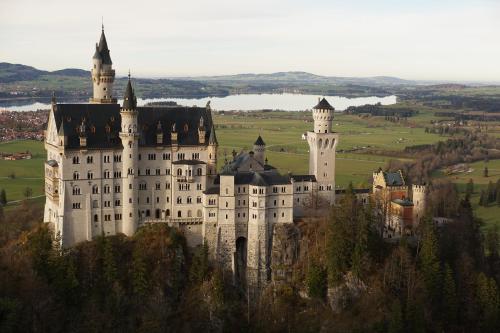
Geography of Germany
Germany can easily be divided into North, South, West, East and Central Germany. The 16 federal states would be more accurate, but the coarser division is easier to remember.
In general, Germany is very densely populated and, for example, over six times more densely populated than the USA. Accordingly, there are few large and contiguous areas where nobody lives. However, this also has its advantages and you can still find beautiful places to hike.
Northern Germany
Lots of coastal regions and little forest, but farmland and heathland. You can also go hiking on various islands and, of course, swim in the northern and baltic sea. Hiking enthusiasts won’t get their money’s worth everywhere here, but people with a canoe will.
Southern Germany
Known for the Alps, but there are also many forests (e.g. the Black Forest or the Bavarian Forest) and other mountains here. Southern Germany makes hikers’ hearts beat faster.
Eastern Germany
Eastern Germany has a lower population density and a lot of agriculture. There are also many forests, but they are often monocultures that are not really beautiful. Nevertheless, there are some hidden gems such as the Mecklenburg Lake District, the Spreewald and, above all, Saxon Switzerland. The latter area in particular is highly recommended!
Western Germany
The exact opposite of East Germany: very densely populated and lots of industry. Nevertheless, there are some beautiful spots, such as the Rhine-Moselle region, the Rothaargebirge or the Palatinate Forest with the transition to the French Northern Vosges.
Central Germany
Even if hardly any German can say exactly what’s here, you will find areas such as the Harz Mountains or the Thuringian Forest that invite you to go hiking. However, much of the forest here also consists of monocultures, but there are still plenty of beautiful spots.
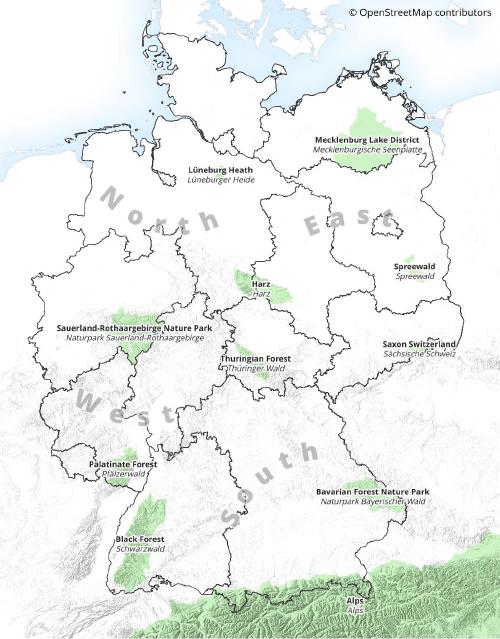
Language
The German language has the stereotype to be harsh, and yes, it has certain sharp sounding noises, but it’s actually not so bad … I hope …
Germany will highly appreciate tourists trying to speak at least a bit German. Therefore, this list gives you some of the most important words and phrases.
I added links to dict.cc where you can listen to spoken examples and also have additional translations.
Formal vs. informal
In the following, there are always formal and informal phrases. But when to use which?
Use formal phrases when …
- entering a bank or other more serious business/store, e.g. a proper restaurant.
- talking with elderly strangers.
Use informal phrases when …
- entering simple stores, e.g. a bakery.
- talking to people you already know, e.g. friendly neighbors on a campsite.
- talking with younger people, meaning younger than 30.
If in doubt, use formal phrases.
Basics
“Ja” (dict) / “Nein” (dict) → “Yes” / “No”
“Danke” (dict) → “Thanks”
“Bitte” (dict) → “Please” and “You’re welcome”.
Same German word for requesting (“please”) and returning / giving something (“you’re welcome”).
“Nicht” (dict) / “Kein” (dict) → “not” / “no”.
Simple negations as in “kein Trinkwasser” for “no drinking water”.
Hello and bye
“Hallo” (dict) → “Hello”.
It’s used just like in English. It’s fine to use this one in all occasions.
“Hi” (dict) → “Hi”.
Not exactly German, but still often used, especially by younger people.
“Guten Morgen/Tag/Abend” (dict) → “Good morning”, “Gidday” / “Hello” and “Good evening”.
“Guten Tag” is a bit more formal version of “Hallo” but not much.
Only in northern Germany:
“Moin” (dict) → “Hello”.
It’s actually not German but Low German (different language!) and I could explain the origin but it basically means “Hello”.
Only in southern Germany:
“Servus” (dict) or “Grüß Gott!” (dict) → “Hello”
“Tschüss” (dict) → “Bye”.
Informal version of bye.
“Auf Wiedersehen” (dict) → “Good bye”.
Literally see you again and is a bit more formal than “Tschüss!”.
“Bis dann!” (dict) → “See ya!”.
Kind of the informal version of “Auf Wiedersehen”.
Relevant for hiking
“Wandern” (dict) → “hiking”
“Weg” (dict) → “path” or “trail”
“Wanderweg” (dict) → “hiking trail”
“Betreten” (dict) → “enter”
“Verlassen” (dict) → “leave”
“Verboten” (dict) → “forbidden”.
And together “Betreten verboten!” means “Do not enter!”. The phrase “Verlassen der Wege verboten!” therefore means “Do not leave the trails!”.
“Berg” (dict) → “mountain”
“Gipfel” (dict) → “summit”
“Wald” (dict) / “Forst” (dict) → “forest”
“Bach” (dict) → “stream”
“Campingplatz” (dict) → “camp site”
“Schutzgebiet” (dict) → “protected area”. Typical use if “Naturschutzgebiet”, which is a protected natural habitat area as described below.
Arrival, departure and mobility
Rental car
In short: Not really necessary, Germany has quite good public transportation.
I live in Germany, I also go hiking here (e.g. in the Thuringian Forest or in the Alps) and I neither own a car nor do I rent one on vacation. If you want to be very flexible, have a lot of luggage or are in a place without public transportation (might happen in very rural areas), then a rental car might make sense. Check this article out, which gives an overview about cars in Germany.
Public transportation
I advise everyone to start without a car and buy the Deutschland-Ticket (also “49€-Ticket”) instead. This allows you to travel all over Germany for one month for only €49, which is simply unbeatable!
This ticket includes busses, trams, subways and all kind of local and regional trains. Long distant and high-speed trains, like EC, IC and ICE trains, are not included! However, a lot of historic and steam trains are partially accepting the ticket.
Shopping and catering
Paying
Cash is still very popular and is basically accepted everywhere (with the possible exception of some hip fancy-pancy coffee shops). Therefore, ATMs can be found everywhere but depending on your card provider, withdrawing money might cost a few Euros. Visa and Mastercard are also widely used and are accepted almost everywhere, at least in all kind of shops, hotels, etc. Other card providers (e.g. American Express) are supported far less frequently. When buying things online, PayPal is the most common payment service.
Shopping facilities
Supermarkets are common in Germany, large shopping centers or malls are only found in metropolitan areas and larger cities. Typical supermarket chains that can be found everywhere: Aldi, Lidl, Edeka, Rewe, Kaufland, Netto and Real. There are no significant price differences between the chains. Cash is accepted everywhere, as are Visa and Mastercard.
Tip: Buy the supermarket’s own brands (e.g. “Gut und günstig” at Edeka or “ja!” at Rewe) and be prepared to pack everything at the checkout as fast as you can - cashiers are very quick!
Important: Shops are closed on Sundays and public holidays! However, places like restaurants, bakeries and gas stations are usually open.
Gastronomy
There are restaurants and pubs in almost every town, especially in tourist areas. Good food is available for 10 - 15 €, soft drinks, e.g. 0.33 L Coca-Cola, are around 3 € and 0.5 L beer costs about 5 €. Some restaurants only accept cash (but this is rarely the case).
The process is usually as follows: Enter the restaurant, ask for a table (or say that you have a reservation), choose and order your food, eat your food, call the waiter and pay. Many Germans leave immediately afterwards, but especially if you order something to drink, it’s totally fine to stay longer.
Tipping. Generally speaking, 10% is usual, but it is also ok not to tip (employees do not dependent on tips). Most people decide according to the quality of the food, drinks and service.
Overnight stay
Hotels / Hostels
There are hotels everywhere in Germany, sometimes even in villages. You can find a decent hotel with breakfast for 60 - 100 € per night, even in tourist areas.
Important: Book early! Prices often differ between high and low season.
Hotels can usually be booked on their website or via portals such as booking.com, hrs.de or hotels.check24.de. Many of them can also be booked without a credit card.
Tip: Some hotels are cheaper on their own website, because external booking websites naturally charge the hotel a commission.
Campsites
There are campsites almost everywhere in Germany, almost 4300 campsites are recorded in OpenStreetMap (an open database for all kinds of geodata). Some campsites can be booked online, but at many you can simply go there and get a pitch. However, it doesn’t hurt to call ahead and make a reservation if necessary. Some larger campsites also offer things like huts, so you don’t need a tent everywhere.
The price with a tent is around €10 - €20 per person per night, depending on the region and season.
Important: Many campsites are closed in winter.
Huts
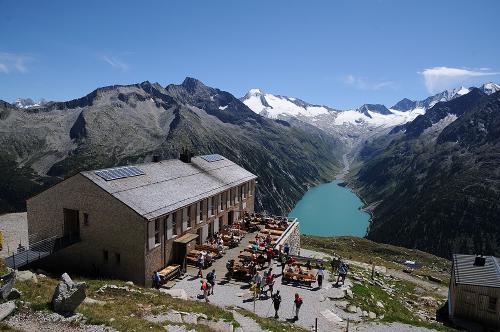
The German Alpine Association (Deutscher Alpenverein, DAV) has various huts in the Alps where you can spend the night. Huts are not free of charge, but you can usually stay for less than €50 per night (less for multi-bed rooms or mattress dormitories). DAV members get a discount.
In addition to DAV huts, there are also private huts, but these are considerably more expensive and are only worthwhile for larger groups.
Important: Many huts are closed in winter or summer.
Wild camping
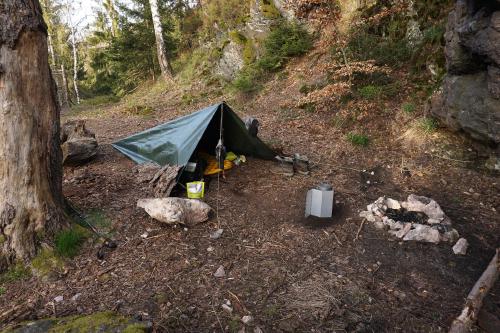
In short: Forbidden in Germany. Period.
However, there are some so-called trekking sites where you are allowed to spend the night in the forest. These are officially designated spots in the forest, some with a fire pit and outhouse, for which you can book an overnight stay online for about 10 - 20 € per tent.
Important: Many trekking sites are closed in winter.
Weather
It all depends on the time of year and the region, so here are a few rules of thumb. By “north” we mean everything north of the Harz mountains, and by “south” we mean everything south of it. For a historical overview, the climate maps from the German Weather Service (DWD) and data from Kachelmannwetter are recommended.
- General
- It generally rains more in the north and east than in the south.
- The higher the altitude, the colder and wetter.
- It often does not rain heavily, but for a few days in a row.
- Early summer (May/June) and early fall (August/September) have the lowest probability of rain.
- Humidity is above 50 - 80 % in summer and in winter at 70 - 100 %.
- Spring & fall
- Everywhere approx. 5 - 15 °C.
- Especially in fall it is often foggy and rainy.
- Winter
- Depending on the region, -10 to +5 °C are common.
- In the north it is approx. 5 °C warmer than in the south due to the coast and fewer mountains.
- It generally rains or snows frequently and for several days at a time.
- Summer
- About 25 - 35 °C are common. On my Rheinsteig-Tour it was around 40 °C on one day.
- Due to the coast, it is about 5 °C cooler in the north than in the south, where there are also more hours of sunshine.
- Short but heavy rain is most likely in summer.
Clothing & equipment
In short: According to the circumstances. Germany has no other special requirements for clothing and equipment.
Of course, it depends on the time of year, but a few words about clothing.
- Sturdy footwear is mandatory (not legally required, but stroingly recommended!). It doesn’t matter whether you wear shoes or boots, the main thing is that you have a secure step and feel comfortable in your shoes.
- Rainproof clothing is also important, even in summer. I recommend ponchos if you don’t want to take a separate rain jacket.
- In winter: Warm clothing according to the temperature. Wool socks and down or fleece jackets are recommended.
- In summer: Sun cream, especially in southern Germany and at higher altitudes. Otherwise, wear airy but long clothing (protects you from the sun, ticks and mosquitoes). Bring enough water!
Good equipment is also important.
- A map is important, as a) you should not rely solely on electronic devices and b) there are places without electricity and internet (as described below in the faq).
- Dictionary / translation app, just in case someone doesn’t speak English.
- Emergency information (see also below), i.e. at least emergency numbers and insurance card.
Hiking trails
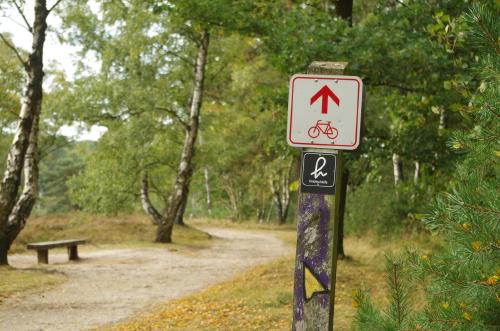
I would say there are four main types of hiking trails, even if this division is anything but common or official.
- Paved paths: Straight paths on which cycle routes run, access roads or even often used forestry tracks; can be paved or even asphalted. However, they are more likely to be found in populated areas and outside forests.
- Forest paths: Often consist of paved ground material or compacted gravel and are wide enough for forest vehicles, trucks and tractors. However, there are also unpaved forest roads deep in forests, which can also become muddy when it rains.
- Hiking trails: Are signposted and are maintained, i.e. fallen trees are removed. The paths surface is not maintained, but there are bridges over streams and railings at difficult passages.
- Paths: Unpaved, unmaintained and not necessarily marked paths. Many of these are not official and therefore not permitted in nature reserves (see protected areas).
Hiking routes can range from paved forest paths to small, challenging trails, so you should check the trail description and rating in beforehand. There are often signposts, signs, information boards, maps and shelters along hiking routes.
It can always happen (without prior notice) that paths are closed, e.g. due to dangers (rockfall, avalanches, ice, etc.), hunting, nature conservation or forestry work.
What is allowed and forbidden
Many things are regulated by laws on federal level, in the individual states and by separate ordinances for each protected area, where details (e.g. making fires) are regulated. In addition, forests are often private property and therefore used for forestry. Nevertheless, a few rules of thumb can be derived.
This is allowed
- Enter the forest for recreation (e.g. hiking). This also applies to private forests!
- Only permitted outside protected areas: picking plants and mushrooms in small quantities (i.e. for personal use).
- Dogs may be taken along, but must be kept on a leash in nature reserves.
This is forbidden
- Spending the night in the forest (whether with a tent, bivouac or anything else).
- See the point above on wild camping.
- Making fires (also outside protected areas).
- Leaving any waste behind (including the remains of e.g. an apple).
- Disturbance (e.g. loud music or bright lights).
- Smoking is sometimes prohibited (depending on the state or season).
Protected areas
Germany contains numerous protected areas of different classes, from nature reserves and national parks (which have a high level of protection) to protected habitats and numerous other types of protection levels.
You are free to enter these protected areas under the main terms listed below. There’s also no fee to pay and no tickets to buy when visiting these protected areas.
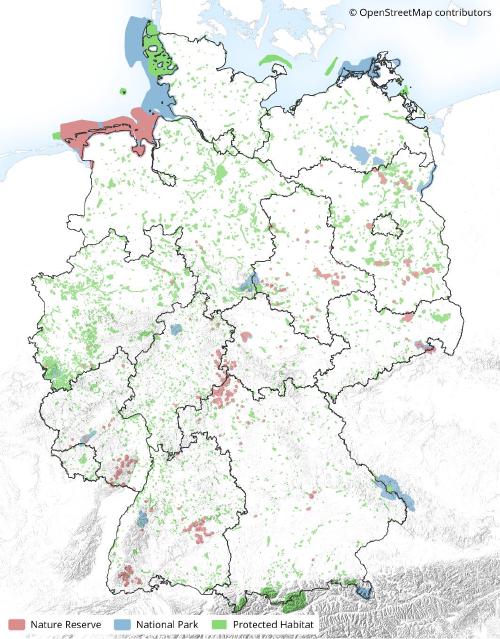
This is forbidden
Even more is prohibited within protected areas, otherwise it would be a bit strange. In protected areas it is additionally forbidden:
- Leaving the marked trails
- Picking or damaging plants and mushrooms
Dangers
In general, Germany is a very safe country for hiking, it could hardly be better. Nevertheless, there are a few things to bear in mind.
Plants and mushrooms
Don’t eat plants or mushrooms you don’t know! There are many berries and shrubs that look harmless and perhaps even smell good, but are nevertheless poisonous or at least unpalatable. There are also a whole handful of plants in Germany that are even deadly.
It’s the same with mushrooms, especially as there are many lookalikes, i.e. poisonous mushrooms that look very similar to edible relatives. Books on mushroom identification are a must, especially for beginners.
Animals
In Germany, there are virtually no deaths caused by animal attacks. Statistically, one person dies every six years as a result of an animal attack.
However, non-fatal attacks occur more frequently. Dangerous wild animals include wild boars, wolves and many insects and spiders such as bees, wasps and especially ticks.
Especially in summer, you should check yourself for tick bites after every tour. They are not dangerous in themselves, but ticks can contain viruses that lead to Lyme disease or TBE.
Terrain
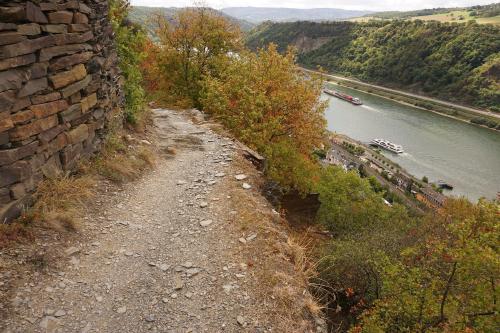
Not every challenging or dangerous path is secured. In rain, ice, snow or poor visibility, you can easily slip or twist somewhere. Check the difficulty of a route beforehand and see if you are up to the challenge.
Other people
Yes, other people can also be dangerous. On Reddit, you often read about psychopaths with weapons who make trails unsafe. I’ve never heard of anything like that in Germany.
There are also hunters here, but usually nothing happens there either. But if an area is closed for hunting, choose an alternative trail ;)
Weather
Unlike, for example, on my trip to Iceland, the weather in Germany rarely changes strongly and quickly. Nevertheless, it can be sunny in the morning and rainy in the afternoon, but the transition is usually slow and gradual. Fog and strong winds can occur, especially at higher altitudes. You should check the weather forecast the evening before and adjust the tour if necessary.
Emergencies
The telephone number for the fire department and rescue services is 112. Sea and mountain rescue services may have a different number, so you should find out in advance.
Important: Get suitable travel insurance! These cover the costs of search, rescue, transportation and operations, although sometimes only up to a certain amount.
Do’s and Don’ts
Here are some important rules of conduct in general and especially for hiking.
General
Clear don’ts
- Don’t get on other people’s nerves. Music while hiking? No-go! Talking loudly in a restaurant? No-go! Forcing conversations on others? No-go.
- Body contact. Simply touching strangers, e.g. patting them on the shoulder, is perceived as intrusive. As soon as you know each other better, it’s a different matter.
- Obey traffic rules. Even if many Germans don’t do this themselves, it’s still an important topic.
- Small talk and artificial politeness. It’s better to be direct and not beat around the bush. For exmaple, no German would think of asking a stranger how they are doing as a form of greeting.
- Respectfully handle the Nazi and WW2 era. The subject is difficult for many Germans and many statements and gestures from that time are rightly illegal.
- Ask instead of demand. It is ok to ask for support, but insisting on it or even pressurizing people is a no-go.
- Taking pictures of people (groups). This is not only incredibly rude, but also illegal. Taking a picture of a scenery with people accidentally being in the picture is ok, though.
- Reducing Germans to stereotypes. Nobody wears lederhosen, not every German likes beer, most Germans are not from Bavaria and no, you are not allowed to drive as fast as you want everywhere on the autobahn.
Clear Do’s
- Greet and say goodbye. As described above, a simple “hallo” and “tschüss” is sufficient.
- Recycling. This is generally appreciated.
- Serious conversation. It is totally fine to start a conversation when the other person is not busy (listening to music, reading, eating, etc.). However, many people find small talk rather annoying.
- Have cash with you. Better safe than sorry, as you can’t pay by card everywhere.
- Speak German. If you can only speak a few words/phrases in German, then let’s hear it. But English is still perfectly fine.
When hiking
Clear don’ts
- Disturbance. Music, loud conversations, phone calls, etc. are rather out of place when hiking.
- Dispose of waste in nature. Waste (even a paper handkerchief or an apple) does not belong in nature! Sometimes there are garbage cans in the forest, but otherwise it is best to simply take your own garbage with you.
- Disregard nature conservation. There are strict rules in protected areas, e.g. do not leave the paths. This must be adhered to.
Clear do’s
- Greet each other when you meet. A simple “hallo” or “hi” is customary when you meet.
- Offer snacks. Is not a must, but is definitely not considered rude. However, if a German refuses, it really means “no”.
- Make way. Priority is given to hikers going uphill. However, mountain bikes do not have priority on hiking trails.
- Respect nature. This not only means to adhere to nature conservation laws, but also, for example, not breaking branches or disturbing animals.
- Collect garbage. And I mean not just your own, but also the garbage you find on the trail. It doesn’t hurt to pick up a chocolate bar wrapper here and there.
FAQ
Here are some topics that are frequently asked.
Do all Germans speak English?
Not all, but definitely most speak English at a high level.
Is there mobile phone reception everywhere?
No, there are dead spots in remote areas.
In Germany, mobile phone coverage is actually quite good, especially in urban areas. However, there can be dead spots in rural areas or in the forest. Especially in valleys or gorges, you can very quickly find yourself completely offline, but there are rarely any problems on hills or peaks. Deep in the Alps, however, the situation may be different.
Are there mosquitoes?
Mosquitoes are everywhere, especially in summer. Especially in stagnant water and wetlands you will be attacked in warm weather. Long clothing, windy days, rain and mosquito spray can help. Fortunately, most mosquitoes are harmless, but there are more and more tropical mosquitoes in Germany and thus also transmitted diseases.
Are there “psychopaths” on the trail?
On Reddit, you often read about unpleasant to dangerous encounters with strange people on hiking trails. I have not yet experienced this in Germany and have not yet heard of it.
Is it safe to go hiking alone?
Hiking as a group is always safer than hiking alone, but there are no particular dangers to fear when solo-hiking. However, women should know that there are a*holes in Germany as well, who can’t keep their looks and stupid remarks to themselves. But I dare say that these are more likely to be found in cities and less on hiking trails.
What is the best time for hiking in Germany?
In my opinion, fall, i.e. mid-September to mid-November. The trees are changing color, there are fewer tourists, no or less mosquitos, all the campsites and huts are still open and it’s not too warm. Yes, the weather can get uncomfortable, but that just means that there are fewer people around and you have your peace and quiet ;)
What are the most beautiful places?
That’s a matter of taste, but here are my personal recommendations: Saxon Switzerland, the Alps, the Bavarian Forest, the northern part of the Rennsteig, the Black Forest, the Lüneburg Heath and the Rheinsteig. But there are many more beautiful places; you can find a lot more online.
Any more questions?
Do you have further questions about hiking in Germany? Then feel free to write a comment or contact me by e-mail (see button below).
What else can I say? Have fun hiking in Germany :)